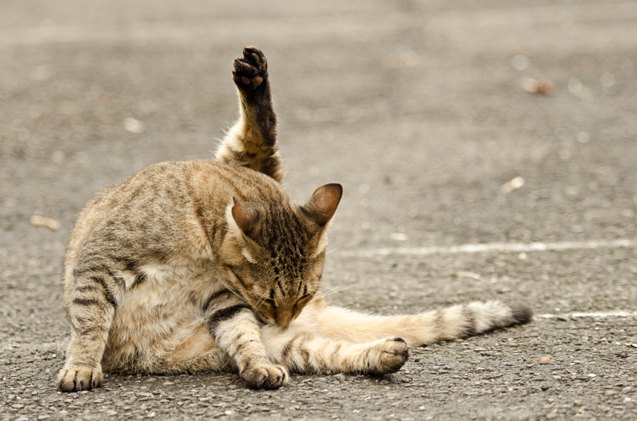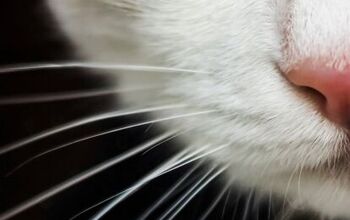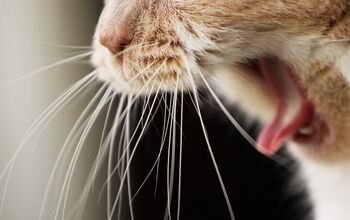Yes, it’s a gross topic, no doubt. But it’s a very important one as well, and we need to talk about it. Cats are creatures known for vomiting every now and then. If you’ve ever owned a cat, you know that they occasionally throw up hairballs or food. And pet parents might even joke about the panic they experience when they realize their cat is about to throw up on the rug. But this isn’t always something to take lightly. While vomiting might be normal in some cases, in others, it is a problem that should be addressed with the help of a veterinarian. When does vomiting become a reason to worry, and when should a cat be taken to the vet for a checkup because of vomiting? To provide some guidance, we’ll cover some basic information on vomiting and why it happens. But remember that if your kitty’s vomiting just doesn’t seem normal, your veterinarian is the best person to call, and it’s best not to wait if your pet is acting abnormally. Related: When A Cat Hairball Is Normal And When It’s NotA List of Some of the Causes of Vomiting in CatsKitties of all ages and breeds may exhibit vomiting as a symptom, but whether or not it is a cause for concern will depend on how often the vomiting occurs and if there is an underlying medical condition that’s to blame.Here is a short list of just some of the common causes of vomiting in cats:Throwing Up HairballsHairballs are common, and you might even begin to recognize the signs that your kitty is about to throw up a hairball. Put simply, they are a result of a cat grooming herself and swallowing a good amount of fur in the process. If the hair doesn’t pass through her digestive tract to be eliminated that way, it will come up the other way by your kitty vomiting and getting it out of her body. Hairballs can vary in size and shape, so your cat’s hairballs may not always look the same. Generally, they are described as being shaped like a cigar. And, as you clean it up, you might be surprised by how thick the clump of fur actually is. When a cat is getting ready to throw up a hairball, you will see and hear her retching before she vomits. However, if you see her doing this but she doesn’t produce anything, it’s best to call your veterinarian because something else might be going on that needs to be checked out. Throwing up hairballs usually isn’t something that you need to be too worried about, as it’s considered a normal behavior for cats. Some cats will get rid of hairballs more often than others, and this is also typically considered normal. However, if you aren’t sure if your cat is vomiting hairballs more often than what would be considered normal, consult with a vet. Or, if you notice that your cat is vomiting hairballs more often than she usually does, it’s best to call your veterinarian to make sure your pet is okay. Your Cat Ate Something She Shouldn’t HaveAnother reason why a cat might vomit is because she ate something that she wasn’t supposed to. For example, spoiled food, plants, poisonous materials, and objects, such as string, might cause a kitty to vomit. Also, if a foreign object is causing an obstruction, vomiting might take place. In this case, vomiting is your cat’s natural way of getting rid of something that isn’t good and shouldn’t be in her body. Basically, by throwing it up and eliminating it that way, the risk of it causing problems is reduced or eliminated. Because of the risk of your cat ingesting something she shouldn’t, it’s important to take steps to keep her safe. Look for objects, substances, food, and materials throughout your home that your cat might be tempted to lick, bite, chew on, or swallow. Then, make sure to keep those out of reach of your frisky feline. And if you suspect that your kitty is vomiting because she ate something that’s bad for her, let your veterinarian know right away, as you’ll want to take action to ensure she’ll be fine. Medical Conditions and Allergies Sure, vomiting might not be a reason for concern in some cases, but there are also various medical conditions that might cause vomiting. For example, if your kitty has a gastrointestinal problem, such as inflammatory bowel disease (IBD), vomiting might occur. Also, if there are internal parasites, or if there’s an infection or an underlying disease like hyperthyroidism, diabetes, or kidney disease, vomiting might be a symptom of the problem. And gastrointestinal growths, whether benign or malignant, might lead to vomiting as well. All of these conditions should be addressed, not ignored, and your veterinarian will be able to guide you at every step to help your kitty feel better. Another thing to keep in mind is that a kitty might vomit if she has a food allergy. Your veterinarian can figure out if this type of allergy is to blame for your cat being unable to keep food down, and will also work on figuring out what is causing the allergy. Adjusting your pet’s diet may be necessary to avoid certain ingredients that don’t agree with your cat’s body, but it will all be worth it because your cat will get relief. The point here is that, because vomiting might be a sign of something more serious going on, it’s wise to talk to your veterinarian to get some answers. Also, if your furry friend is exhibiting other symptoms in addition to the vomiting, your vet can examine her, determine if a medical problem is to blame, and prescribe the appropriate treatment. Your Cat Needs to Eat If your kitty hasn’t eaten in a while, she might end up throwing up some liquid, and it might also look foamy. For this reason, it’s a good idea to set a feeding schedule that will be easy to follow and will ensure your feline is fed regularly and won’t end up with an empty stomach. As always, if this type of vomiting occurs often and you don’t think it has anything to do with an empty stomach, contact your veterinarian to figure out what’s causing your cat to throw up. Related: Fun Facts About Cat HairballsWhat Cat Vomit Can Look LikeOkay, we know that this is gross, but taking a look at your cat’s vomit to see its color and consistency might help you and your veterinarian figure out the cause behind it. So, before you rush to clean up the mess, take note of its appearance. That way, you can give your vet more details that may be able to shed some light on whether or not the vomiting is a cause for concern.Here are just some of the things you might find when your kitty vomits. Keep in mind that these are listed here just to give you a basic idea of what might be going on, but talking to your vet is the ideal way to get answers.Pieces of food – If your feisty feline ate her food too quickly, if she ate too much food, or if she’s allergic or intolerant to something she ate, she might throw it up. However, this might also occur if there’s an obstruction or other problem that’s preventing food from moving through the digestive tract like it should. By observing your pet’s behavior and looking for other symptoms, you might be able to more easily determine why she’s throwing up her food. Also, consider if you’ve switched to a new food that might not be good for your particular cat. Mucus – If you see mucus on the floor, this might be a sign of regurgitation, not vomiting. And you might see this with regurgitated food.Clear or watery liquid – If your kitty drank a lot of water (this might be caused by a medical problem like diabetes), she might end up throwing up clear liquid. However, this could also be caused by your pet’s stomach being empty. Foamy fluid – If there is inflammation or irritation within the digestive tract, your furry friend might throw up a foamy, white liquid. Also, as mentioned above, if she goes a while without eating, she might throw up a foamy fluid that’s white or yellow in color. And she might even throw up a foamy liquid before throwing up a hairball.Green liquid or yellow bile – If your cat’s stomach is empty from going a while without eating, she might end up vomiting bile that looks yellow. And if the vomit is green, this may be the result of bile being mixed in, too. However, this might also occur if your kitty is refusing to eat or if she has a medical condition that needs to be treated by a veterinarian. Brown fluid – If your cat vomits and you find brown liquid, it might just be that she ate something brown. However, this type of vomit might also indicate that there might be blood in the gastrointestinal tract, perhaps because of a foreign body or ulceration. Blood – If you notice blood in your cat’s vomit, alert your vet. Depending on where the blood is coming from, it might appear red or it might look like coffee grounds. Perhaps it’s because your kitty has been vomiting a lot and the esophagus or stomach became irritated. Or, this might indicate poisoning, a medical condition, or an ulcer. Remember, when you talk to your vet about your cat’s vomit, don’t be reluctant to go into detail about the color, consistency, and overall appearance of it, as well as how much your kitty is vomiting and how often it’s happening. Also, bear in mind that, even if your cat’s vomit looks like it might be caused by something benign and temporary, this might not necessarily be the case. If your pet is throwing up a lot of any of the above types of vomit, if she’s vomiting often, or if she is making attempts to vomit but nothing comes out, contact your veterinarian right away. When to Call the VetIf your kitty is vomiting a lot—such as more than once a day or for several days in a row—it’s best to call your vet for a checkup. Also, if you notice any other symptoms, such as a change in your pet’s appetite, an inability to keep food down, weakness, lethargy, changes in behavior or grooming, or blood in the vomit, it’s time to take the vomiting seriously and call your veterinarian.No matter how experienced you are as a cat owner, seeing your pet vomit can be unnerving and make you wonder if something is wrong with your companion. Never hesitate to call your veterinarian to ask them questions about your furry friend’s condition if you aren’t sure. It’s better to be safe than sorry, and to address a problem as soon as possible before it progresses. Diagnosing the Cause of the VomitingVomiting that’s considered chronic or severe is a cause for concern, and it can lead to other issues, such as dehydration and electrolyte imbalance, so you should talk to your vet right away. Acute, minor vomiting that only lasts a short while, on the other hand, might not be a serious issue, but you may want to ask your vet to be sure. Again, there’s no shame in asking questions about your unique feline and what is considered normal for her!Whether or not the vomiting is worrisome will depend on what your veterinarian finds during an examination. In addition to discussing the frequency of the vomiting and the way the vomit looks, be sure to tell the vet about all of your pet’s symptoms. You can also talk about her overall behavior and any changes you’ve noted in the way she’s been acting. And, if you’ve changed your cat’s food or introduced a new food or treat, let the veterinarian know about that, too. There are several things that vets can do to figure out what’s going on. For example, your vet can perform tests, such as a fecal exam and blood test, to figure out if there are any diseases, parasites, or toxicity that’s causing the vomiting. They might also order a biopsy to rule out conditions like IBD or cancer. And imaging tests like an ultrasound or x-rays can be used to see if there are any ailments of the gastrointestinal tract that might be causing the vomiting, if there are foreign objects in the digestive tract, or if there are masses that are causing problems. Also, if food intolerance or allergies are suspected, they might advise doing a food trial or elimination diet to figure out which ingredients need to be avoided. Treatments Are AvailableVeterinarians can provide a range of treatments to help a vomiting cat feel better. Fluid therapy, medications like antiemetic drugs, and changes in diet might be recommended. Ultimately, the treatment will be based on the diagnosis. So, if there are parasites, treatments to remove them will be ordered, whereas obstructions might need surgical removal, and infections might require antibiotics, as a few examples.If the vomiting is considered acute and mild, your veterinarian might start by recommending that you fast your kitty for a certain number of hours before providing her with a small amount of a bland diet that’s easy to digest. Gradually, you’ll reintroduce her normal diet once the symptoms subside.Your Vet Will Know If You Need to Be WorriedKeep in mind that vomiting is a symptom, not a disease. If your healthy kitty occasionally vomits, your vet might say that it isn’t anything to worry about. On the other hand, if your cat is vomiting a lot or showing other symptoms, your veterinarian can help by diagnosing the cause and recommending the appropriate treatments to help your pet feel good again.

























